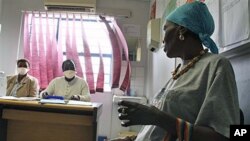Scientists say new insights into a common tuberculosis drug will make it possible to shorten the treatment period for patients infected with TB.
The drug "pyrazinamide" is widely used in combination with other drugs to treat active tuberculosis infections. Now, doctors are learning more about how it works - and calling the new information a "breakthrough."
The standard therapy for treating active tuberculosis infections today is to give patients a combination of four drugs, taken over a period of six months.
Forty years ago, TB treatment took much longer - until what experts call the "breakthrough drug" came along.
Dr Clifton Barry, who directs tuberculosis research at the National Institutes of Health, said, “Pyrazinamide allowed that period to be shortened to six months - compared to two years. It was dramatic breakthrough in the 1970s.”
He said scientists have long known that pyrazinamide, by itself, does not destroy the active TB bacterium. But research has now revealed that the drug does kill the latent form of the microbe, which does not cause observable symptoms.
With their improved understanding of how pyrazinamide actually works at the molecular level, Barry said scientists will be able to design a more potent form of the drug that could shorten the duration of TB treatment from six months to just two.
“Before, it was a completely empirical approach: Just try anything you can and see if that kills the bacteria a little more quickly or under certain non-replicating conditions. Now, with [our knowledge of the drug's] molecular mechanism, all of a sudden we can use all the tools of modern drug discovery, which means structure-based, protein-targeted approaches,” said Barry.
Dr. Barry believes this new, more targeted use of pyrazinamide could finally break the back of the global TB epidemic, which has infected nearly one third of the world’s population. While more than 8 million people are sick with the highly contagious active form of TB, an estimated two billion people carry the latent form - with no symptoms.
“Remember that every case that develops into active disease spreads it to at least 10 more people. And so instead of treating those 10 people, if we start to treat the people before they get sick - who are asymptomatic - then we can really make a huge difference in how many people get sick with the disease."
Experts are applauding the new insights into this important TB drug, and the prospects for improved therapies. But they say the best way to slow the global tuberculosis epidemic is to match these treatment gains with similar strides toward faster, more reliable TB testing.











